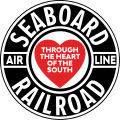History
The Orlando Subdivision was built by predecessors of the Seaboard Air Line Railroad.
The Leesburg and Indian River Railroad was incorporated in 1884, and they built line from Wildwood east to Tavares, with plans to continue east to Titusville. That extension was not built, but pieces were built by other companies. The Leesburg and Indian River Railroad merged into the Florida Railway and Navigation Company in 1885. The Florida Railway and Navigation Company would become part of the Florida Central and Peninsular Railroad (FC&P) in 1886.
The Tavares, Orlando and Atlantic Railroad was incorporated in 1883, and built an extension from Tavares to Orlando. The FC&P leased the Tavares, Orlando and Atlantic Railroad in 1891.
The Orlando and Winter Park Railway was incorporated in 1886 and extended the line from Orlando to Winter Park. The Osceola and Lake Jesup Railway, incorporated 1888, continued the line past Oviedo to Lake Charm. In 1891 the two companies merged into the East Florida and Atlantic Railroad, which was leased by the FC&P in 1892.
In the line's early days, the FC&P's passenger trains served the historic Church Street Station in Orlando, which belonged to the South Florida Railroad. [1] Trains would turn on to the South Florida Railroad (which would become the main line of the Atlantic Coast Line Railroad, the Seaboard Air Line's competitor) in Downtown Orlando just north of the station. In 1896, the FC&P would build its own Orlando station, which would continue to be used by Seaboard. [2]
The Seaboard Air Line Railway leased the Florida Central and Peninsular Railroad network on July 1, 1900, and it was merged into the former on August 15, 1903. The Seaboard Air Line would designate the line as the Orlando Subdivision. In the 1940s, Seaboard ran two round trip freight trains daily on the line from Wildwood to Orlando, with one of those trains continuing to Oviedo. They also operated one daily mixed train (both passengers and freight) daily from Wildwood to Orlando. [3]
In 1967, the Seaboard Air Line merged with their long-time rival, the Atlantic Coast Line Railroad (ACL). The Orlando Subdivision crossed some ACL branch lines between Wildwood and Orlando, and also connected with the ACL's main line in Orlando. [4] After the merger was complete, the company was named the Seaboard Coast Line Railroad (SCL).
After the merger, the Orlando Subdivision was abandoned between Orlando and Aloma (just east of Winter Park). The remaining track from Aloma to Lake Charm became part of the Aloma Subdivision, which also included the former ACL line from Sanford to Oviedo. [5] [6] The line between Wildwood and Orlando remained intact until the 1970s when tracks were removed between Leesburg and Tavares. [7]
Current conditions
Since 1986, the remaining line from Tavares to Orlando has been operated by the Florida Central Railroad, a short line that was run by the Pinsly Railroad Company from 1986 to 2019 and is now operated by Regional Rail, LLC. [8]
The Florida Midland Railroad, another Pinsly-operated short line, operated the segment from Wildwood to Leesburg from 1987 until 2005, when most of that end of the line was abandoned. All that remains on the Wildwood end is a short wye which CSX uses to turn locomotives from Wildwood Yard.
This page is based on this
Wikipedia article Text is available under the
CC BY-SA 4.0 license; additional terms may apply.
Images, videos and audio are available under their respective licenses.



